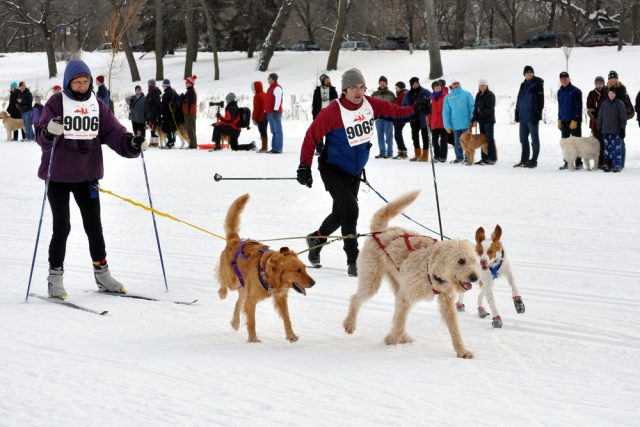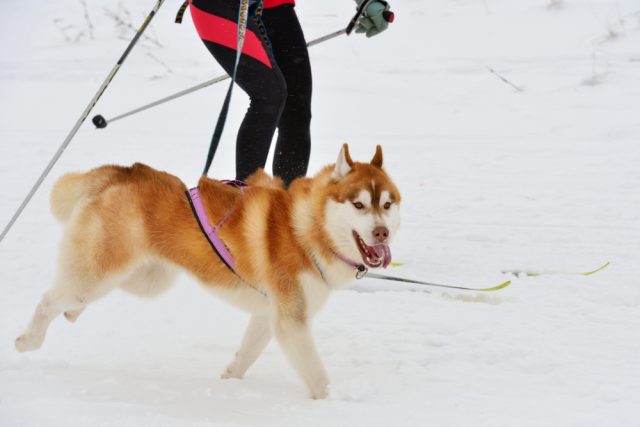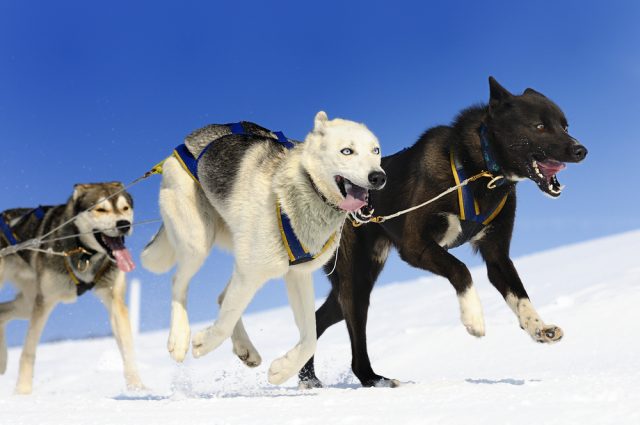When sledding, snowboarding, and skiing get old, animal lovers turn to a more extreme kind of winter sport. It’s not as well-known as dog sledding, but skijoring is kicking up powder in terms of popularity. The underrated activity is like dog sledding without the sled and skiing with the added twist of being pulled by either canine or equine.
It’s the challenge of staying on your skis while being towed by your favorite four-legged partner. Extreme sport enthusiasts are skijoring their way across the country, and the trend is picking up speed as a thrilling winter time boredom buster.

Originating in Scandinavia, skijoring is Native American dog sledding with distinct adjustments based on Scandinavian practicality. Large packs of dogs and heavy sleds didn’t make sense in densely populated Scandinavian cities. They were too bulky to move fast, so drivers lightened the load. They dropped the number of dogs down to only one or two, and they only used the sled for carrying cargo.
Instead of leisurely riding along while letting the dogs do the work, drivers instead donned skis and propelled themselves through the snow with help from the dogs. Horses eventually entered the equation, and the sport was used for practical purposes like delivering mail and checking hunting snares.

Today, skijoring is mostly done for fun. It’s not as common in the U.S. as in Europe, but there are still clubs, organizations, and individuals that rejoice in the thrill and adrenaline of being pulled at breakneck speeds through snowy landscapes. To get started, it’s best to already be familiar with being on skis.
Downhill skiers and cross-country skiers already know how to maneuver in the snow, and they’ll have an advantage when learning to add a dog or horse to the mix. Wakeboarders and water skiers also have an easier transition in using core strength to remain upright while being pulled.
While staying vertical is the first challenge, learning to work with your four-legged propulsion system can be even harder. Dog trainers and equestrians turn to skijoring for the opportunity to work with their favorite animals. Whether you have a dog or a horse, you’ll need some semblance of control.
With horses, the driver holds on to a set of reins attached to the horse’s saddle. Another rider in the saddle usually controls the horse. It’s different for dogs. The dogs are typically strapped into harnesses connected by a tether to the driver’s belt. The driver needs their arms for the ski poles, and the dogs are mostly directed with shouted commands.

For those interested in strapping on skis and getting started, there are group clinics and lessons available at ski resorts and ranches in Colorado, Minnesota, Utah, and several other states. Most provide equipment rental, and they lead newbies through the basics of the sport.
Besides paid-for lessons, experienced skiers can get started on their own anywhere with fresh powder. Besides skis, you’ll need the proper harness, towline, boots, bindings, and winter clothing. Oh, and don’t forget the dog or horse.
Once you have all the necessary components, skijoring can be done almost anywhere with open space that allows animals. A park that allows dogs on leash is a good option, and the back country trail you usually take in the summer will also be there in winter. Skijoring with dogs is usually the easier and less involved option, especially if you already have a dog rearing to go for a run.

Skijoring enthusiasts say dogs should be at least 35 pounds, but there’s no specific breed requirement. Huskies and Alaskan Malamutes obviously do well, but Labs, Rhodesian Ridgebacks, Collies, and even Poodles are also good at the game. Any dog with a need for speed and general willingness to listen to commands has potential. Pulling is a natural instinct for most dogs, and teaching your pup to tow you through the snow might not be as hard as you think.
Falling down your first few tries is inevitable, but with practice, it’s a great way to get active and bond with your favorite four-legged friend.
 Toledo, United States.
Toledo, United States.